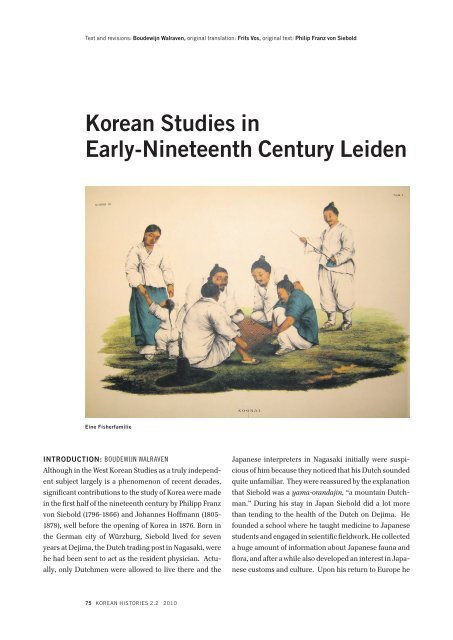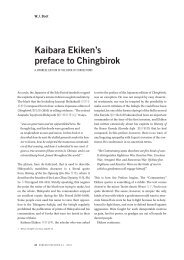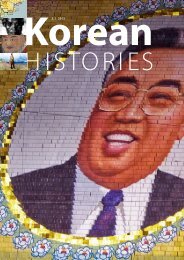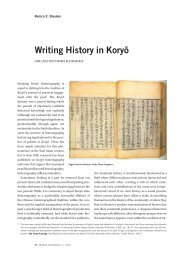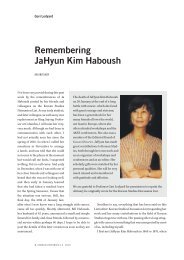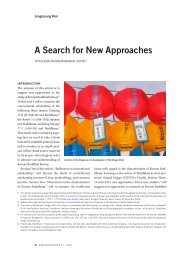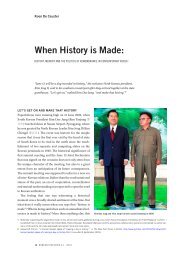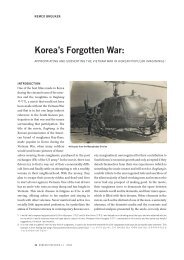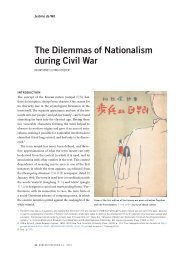Korean Studies in Early-nineteenth century Leiden - Korean Histories
Korean Studies in Early-nineteenth century Leiden - Korean Histories
Korean Studies in Early-nineteenth century Leiden - Korean Histories
Create successful ePaper yourself
Turn your PDF publications into a flip-book with our unique Google optimized e-Paper software.
Text and revisions: Boudewijn Walraven, orig<strong>in</strong>al translation: Frits Vos, orig<strong>in</strong>al text: Philip Franz von Siebold<br />
<strong>Korean</strong> <strong>Studies</strong> <strong>in</strong><br />
<strong>Early</strong>-N<strong>in</strong>eteenth Century <strong>Leiden</strong><br />
E<strong>in</strong>e Fisherfamilie<br />
<strong>in</strong>troduction: Boudewijn Walraven<br />
Although <strong>in</strong> the West <strong>Korean</strong> <strong>Studies</strong> as a truly <strong>in</strong>dependent<br />
subject largely is a phenomenon of recent decades,<br />
significant contributions to the study of Korea were made<br />
<strong>in</strong> the first half of the n<strong>in</strong>eteenth <strong>century</strong> by Philipp Franz<br />
von Siebold (1796-1866) and Johannes Hoffmann (1805-<br />
1878), well before the open<strong>in</strong>g of Korea <strong>in</strong> 1876. Born <strong>in</strong><br />
the German city of Würzburg, Siebold lived for seven<br />
years at Dejima, the Dutch trad<strong>in</strong>g post <strong>in</strong> Nagasaki, were<br />
he had been sent to act as the resident physician. Actually,<br />
only Dutchmen were allowed to live there and the<br />
Japanese <strong>in</strong>terpreters <strong>in</strong> Nagasaki <strong>in</strong>itially were suspicious<br />
of him because they noticed that his Dutch sounded<br />
quite unfamiliar. They were reassured by the explanation<br />
that Siebold was a yama-orandaj<strong>in</strong>, “a mounta<strong>in</strong> Dutchman.”<br />
Dur<strong>in</strong>g his stay <strong>in</strong> Japan Siebold did a lot more<br />
than tend<strong>in</strong>g to the health of the Dutch on Dejima. He<br />
founded a school where he taught medic<strong>in</strong>e to Japanese<br />
students and engaged <strong>in</strong> scientific fieldwork. He collected<br />
a huge amount of <strong>in</strong>formation about Japanese fauna and<br />
flora, and after a while also developed an <strong>in</strong>terest <strong>in</strong> Japanese<br />
customs and culture. Upon his return to Europe he<br />
75 <strong>Korean</strong> <strong>Histories</strong> 2.2 2010
<strong>Korean</strong> <strong>Studies</strong> <strong>in</strong> <strong>Early</strong>-N<strong>in</strong>eteenth Century <strong>Leiden</strong><br />
Scriptura cooraiana<br />
settled <strong>in</strong> <strong>Leiden</strong> and between 1832 and 1852 published<br />
his f<strong>in</strong>d<strong>in</strong>gs about Japan and Japan’s neighbour<strong>in</strong>g<br />
countries <strong>in</strong> what eventually turned <strong>in</strong>to a five-volume<br />
work: Nippon: Archiv zur Beschreibung von Japan und<br />
dessen Neben- und Schutzländern Jezo mit den südlichen<br />
Kurilen, Sachal<strong>in</strong>, Korea und den Liu-Kiu-Inseln (Nippon:<br />
archive for the description of Japan and its neighbour<strong>in</strong>g<br />
and protectorate countries, Jezo with the southern<br />
Kuriles, Sachal<strong>in</strong>, Korea and the Ryukyu Islands).<br />
In Nagasaki Siebold sometimes had opportunities<br />
to meet shipwrecked <strong>Korean</strong>s who lived <strong>in</strong> the Chōsen<br />
yashiki (“Korea House”, an establishment ma<strong>in</strong>ta<strong>in</strong>ed by<br />
the lord of Tsushima) near his own quarters, and tried to<br />
elicit <strong>in</strong>formation about their country from them. He also<br />
<strong>in</strong>terrogated Japanese who had been to Tsushima and the<br />
Japanese trad<strong>in</strong>g post <strong>in</strong> Pusan about Korea. Already <strong>in</strong><br />
1824 he sent a han’gŭl chart to The Netherlands (where it<br />
aroused no <strong>in</strong>terest whatsoever at the Royal Dutch Academy,<br />
as Siebold sourly remarks <strong>in</strong> a footnote <strong>in</strong> Nippon).<br />
After his return he was jo<strong>in</strong>ed <strong>in</strong> <strong>Leiden</strong> by his fellow-<br />
Würzburger Hoffmann, whom he had accidentally met <strong>in</strong><br />
a hotel <strong>in</strong> Antwerp where he had asked him to become his<br />
research assistant. Hoffmann was a somewhat curious<br />
choice for the job, as he had been tra<strong>in</strong>ed as a s<strong>in</strong>ger. Nevertheless,<br />
he proved to be a competent scholar and eventually,<br />
<strong>in</strong> 1856, became <strong>Leiden</strong> University’s first professor<br />
of Japanese. Together Siebold and Hoffmann devoted 162<br />
pages, not count<strong>in</strong>g the illustrations, of Nippon to Korea<br />
(which they called Kooraï, <strong>in</strong> the Japanese way). In this<br />
enterprise they were assisted by a Ch<strong>in</strong>ese gentleman, Ko<br />
Tsch<strong>in</strong>g Dschang (Guo Chengzhang).<br />
Siebold first wrote <strong>in</strong> general about the <strong>Korean</strong> castaways<br />
he observed <strong>in</strong> Nagasaki. In his description one of the<br />
most notable features is his keen <strong>in</strong>terest <strong>in</strong> race. Whereas<br />
<strong>in</strong> Hendrik Hamel’s seventeenth-<strong>century</strong> description of<br />
Korea race is not mentioned at all, by the early n<strong>in</strong>eteenth<br />
<strong>century</strong> the discourse of race (often phrased <strong>in</strong> anatomical<br />
terms, but also cover<strong>in</strong>g less tangible characteristics like<br />
temper and mentality) structured an important part of<br />
Siebold’s descriptions. Subsequently, Siebold provided<br />
a detailed account of a meet<strong>in</strong>g he had with a number of<br />
<strong>Korean</strong> castaways on 17 March, 1828. An English translation<br />
by Frits Vos of these two descriptions is given below.<br />
Not translated from the first section with <strong>in</strong>formation<br />
about Korea, are remarks about language and writ<strong>in</strong>g<br />
systems, translations <strong>in</strong>to German of a vernacular song<br />
and Ch<strong>in</strong>ese poems the <strong>Korean</strong>s wrote down or composed<br />
dur<strong>in</strong>g the meet<strong>in</strong>g, and brief general <strong>in</strong>formation about<br />
the geographical features, the climate, the economy,<br />
the adm<strong>in</strong>istration and the religions of the pen<strong>in</strong>sula<br />
76 <strong>Korean</strong> <strong>Histories</strong> 2.2 2010
<strong>Korean</strong> <strong>Studies</strong> <strong>in</strong> <strong>Early</strong>-N<strong>in</strong>eteenth Century <strong>Leiden</strong><br />
obta<strong>in</strong>ed from the <strong>Korean</strong>s Siebold<br />
met as well as from Japanese who<br />
had been <strong>in</strong> contact with <strong>Korean</strong>s<br />
on Tsushima and <strong>in</strong> Pusan. The first<br />
chapter about Korea was followed<br />
by a list of 455 <strong>Korean</strong> words, based<br />
on a list of characters, of which the<br />
<strong>Korean</strong> pronunciation and the S<strong>in</strong>o-<br />
<strong>Korean</strong> read<strong>in</strong>g are given, together<br />
with the S<strong>in</strong>o-Japanese and Japanese<br />
read<strong>in</strong>gs. The next section was<br />
a translation from a Japanese book,<br />
Chōsen monogatari (Tales of Korea)<br />
published <strong>in</strong> Edo <strong>in</strong> 1750, <strong>in</strong> which<br />
it is related how Japanese traders<br />
<strong>in</strong> 1645 drifted to the coast to the<br />
north of Korea and via Manchuria<br />
and Korea were sent back to their<br />
fatherland. From the same source<br />
a description of the adm<strong>in</strong>istrative<br />
structure of Korea, with the names of<br />
various civil and military offices was<br />
extracted.<br />
Nippon was published <strong>in</strong> <strong>in</strong>stallments<br />
and so it could happen that<br />
after the wordlist mentioned above<br />
had been pr<strong>in</strong>ted, a similar list was<br />
obta<strong>in</strong>ed which was <strong>in</strong>cluded <strong>in</strong> a<br />
follow<strong>in</strong>g edition of the book. A version<br />
of the Yuhap 類 合 (a primer to<br />
learn Ch<strong>in</strong>ese characters) was put<br />
at the disposition of the scholars <strong>in</strong><br />
<strong>Leiden</strong> by the Freiherr von Schill<strong>in</strong>g-<br />
Canstadt, who <strong>in</strong> turn had obta<strong>in</strong>ed<br />
it from a Catholic priest, Father Hya-<br />
Koorai<br />
c<strong>in</strong>th, archimandrite of the mission <strong>in</strong> Beij<strong>in</strong>g. Hoffmann<br />
prepared a critical translation of this book with an <strong>in</strong>troduction<br />
about the <strong>Korean</strong> language and writ<strong>in</strong>g systems.<br />
He also edited a similar text, the Thousand Character Text<br />
千 字 文 (published as an appendix), the orig<strong>in</strong>al of which<br />
now is held by the Museum of Ethnology <strong>in</strong> <strong>Leiden</strong> (which<br />
grew out of the collections Siebold had assembled).<br />
Hoffmann also spent a great deal of effort on the next<br />
chapter, a survey of “Japan’s relations with the <strong>Korean</strong><br />
pen<strong>in</strong>sula and Ch<strong>in</strong>a, based on Japanese sources,” preceded<br />
by an outl<strong>in</strong>e history of Korea. He began with<br />
the myth of Tan’gun, on the basis of the account of the<br />
Tongguk t’onggam 東 國 通 鑑 Comprehensive Mirror of<br />
the Eastern Country, which he could not consult directly<br />
but found quoted <strong>in</strong> Japanese sources, and concluded his<br />
account with the Manchu campaign aga<strong>in</strong>st Chosŏn <strong>in</strong><br />
1637. Although he had to rely on Japanese sources, he<br />
was aware of their limitations, and attempted to ma<strong>in</strong>ta<strong>in</strong><br />
critical distance and qualify their value. He did not<br />
have the means to question Japanese accounts of <strong>in</strong>fluence<br />
on the <strong>Korean</strong> pen<strong>in</strong>sula <strong>in</strong> ancient times, but sometimes<br />
used the term legends to characterize the sources.<br />
He also devoted considerable attention to the transfer of<br />
culture from Korea (particularly from Paekche) to Japan,<br />
77 <strong>Korean</strong> <strong>Histories</strong> 2.2 2010
<strong>Korean</strong> <strong>Studies</strong> <strong>in</strong> <strong>Early</strong>-N<strong>in</strong>eteenth Century <strong>Leiden</strong><br />
Kaufleute und Schiffsvolk<br />
with for <strong>in</strong>stance seamstresses arriv<strong>in</strong>g <strong>in</strong> 282 and scholars<br />
who <strong>in</strong>troduced Ch<strong>in</strong>ese writ<strong>in</strong>g <strong>in</strong> 284. Interest<strong>in</strong>g<br />
is his qualification of Parhae as created by “a special<br />
branch” of the nation of Koguryŏ (p. 98).<br />
The f<strong>in</strong>al part of the sections of Nippon about Korea<br />
consists of explanations of the illustrations. The contents<br />
are mostly similar to the general description <strong>in</strong> the first<br />
section. Sometimes a few details are added. About the<br />
portrait of Hŏ Sach’ŏm (Siebold writes Hôsa tsêm), one<br />
of the people he met on 17 March, 1828, Siebold remarks<br />
that among all those present his features were the closest<br />
to the Caucasian race, although “less f<strong>in</strong>e” because of the<br />
pronounced bone structure. Hŏ was judged to be most<br />
representative <strong>in</strong> looks of the elite and Siebold praises<br />
his educational achievements. He was “e<strong>in</strong> Mann von Bildung”<br />
with ref<strong>in</strong>ed manners. Siebold was also impressed<br />
by his headgear, a fur cap that only left the face uncovered:<br />
“a very effective piece of cloth<strong>in</strong>g <strong>in</strong> cold climes,<br />
which really deserves to be copied.” The last illustration<br />
is a copy of a Japanese map of Korea. Siebold notes that<br />
Hoffmann had gone to great lengths to render the place<br />
names on this map <strong>in</strong> S<strong>in</strong>o-<strong>Korean</strong> pronunciation, and<br />
utters the desire that henceforth all geographical works<br />
about Korea will use this term<strong>in</strong>ology.<br />
Koorai co<strong>in</strong>s<br />
78 <strong>Korean</strong> <strong>Histories</strong> 2.2 2010
<strong>Korean</strong> <strong>Studies</strong> <strong>in</strong> <strong>Early</strong>-N<strong>in</strong>eteenth Century <strong>Leiden</strong><br />
Notes on Kooraï<br />
from contact with some Koraaians<br />
stranded on the Japanese coast<br />
Pictures of <strong>Korean</strong> Fishermen<br />
orig<strong>in</strong>al text: Philip Franz von Siebold,<br />
translation: Frits Vos,<br />
revision: Boudewijn Walraven<br />
Nearly every year Kooraian (kooraïsche] fish<strong>in</strong>g boats<br />
and coastal vessels drift off to the Japanese coast<br />
because of the north-westerly storms that are predom<strong>in</strong>ant<br />
<strong>in</strong> spr<strong>in</strong>g. Therefore the Japanese government has<br />
made arrangements to transport these stranded vessels<br />
and the castaways to Nagasaki, the only place where foreigners<br />
may reside, where under the protection and at the<br />
expense of the Lord of Tsusima, who has been put <strong>in</strong> control<br />
of the political and commercial affairs between Japan and<br />
Kooraï, they are taken care of <strong>in</strong> a build<strong>in</strong>g belong<strong>in</strong>g to<br />
him, and from there returned to the island of Tsusima and<br />
then to their homeland. And so one sees fishermen, sailors<br />
and merchants, often with several families, with wives<br />
and children, arrive <strong>in</strong> Nagasaki, and because the Lord<br />
of Tsusima’s trad<strong>in</strong>g post is located quite near the Dutch<br />
factory on Dezima, we have the opportunity to observe<br />
these people closely <strong>in</strong> all their com<strong>in</strong>gs and go<strong>in</strong>gs and<br />
<strong>in</strong> their daily life. They often live there for several months<br />
wait<strong>in</strong>g for a favourable w<strong>in</strong>d, and keep themselves occupied<br />
by repairs to their vessels, the mak<strong>in</strong>g of utensils<br />
and other manual labour. Although the place where they<br />
live is very simple, even poor, this is amply compensated<br />
for by the food, the excellent Japanese rice, the f<strong>in</strong>e vegetables<br />
and fish, and the unlimited freedom they enjoy<br />
to visit the town and to enter the houses of the k<strong>in</strong>d and,<br />
to the unfortunate, so hospitable Japanese, which even<br />
makes these poor castaways an object of envy to us, who<br />
are liv<strong>in</strong>g <strong>in</strong> affluence and European luxury, but are state<br />
prisoners all the same.<br />
The Kooraian is taller than the Japanese, although<br />
rarely more than 5½ Parisian feet, with a strong build,<br />
and well-balanced features, calm and nimble. The shape<br />
E<strong>in</strong> Kuestenfahrer (all picture plates reproduced here are from Nippon)<br />
of his face <strong>in</strong> general has the characteristics of the Mongolian<br />
race: the wide, coarse face, with prom<strong>in</strong>ent cheekbones;<br />
the strong jaw; the flat bridge and wide w<strong>in</strong>gs of<br />
the nose; the rather big mouth with wide lips; the curious,<br />
apparently slanted form of the eyes; the coarse,<br />
thick, blackish hair, often <strong>in</strong>cl<strong>in</strong><strong>in</strong>g to a reddish-brown;<br />
the prom<strong>in</strong>ent eyebrows, the th<strong>in</strong> beard, together with a<br />
reddish-yellow or whitish complexion – all these make<br />
it possible to recognize him as an <strong>in</strong>habitant of North-<br />
East Asia. The majority of the Kooraians I have observed<br />
belong to this type, and they themselves recognize it as<br />
the most characteristic of their nation.<br />
However, <strong>in</strong> the facial features of the Kooraians one<br />
can see the characteristics of two races (Volksstämme).<br />
The nose that is flat next to the corners of the eyes, then<br />
spreads wide lower down, the slanted eyes that stand far<br />
79 <strong>Korean</strong> <strong>Histories</strong> 2.2 2010
<strong>Korean</strong> <strong>Studies</strong> <strong>in</strong> <strong>Early</strong>-N<strong>in</strong>eteenth Century <strong>Leiden</strong><br />
E<strong>in</strong> Schiffsjunge<br />
E<strong>in</strong> Schiffsknecht<br />
apart, and the more prom<strong>in</strong>ent cheekbones are marks of<br />
the race described above (to which the likenesses <strong>in</strong> pictures<br />
VI, VII and VIII belong); but if the top of the nose<br />
is high, and the nose more pronounced, then the facial<br />
features are closer to those of the Caucasians, and the<br />
shape of the eyes, too, becomes more like that of Europeans.<br />
Here the cheekbones are less pronounced, and<br />
the sharp profile that is absent <strong>in</strong> the Mongolian race<br />
becomes visible. The closer a person’s facial features are<br />
to the race described first, the less beard that person will<br />
have, whereas <strong>in</strong>dividuals with a sharp profile often have<br />
quite a heavy beard. The skull of the latter is less compressed,<br />
their foreheads are straighter, rather than slop<strong>in</strong>g<br />
back, and <strong>in</strong> their entire appearance they possess a<br />
k<strong>in</strong>d of nobility, which one misses <strong>in</strong> the rough features<br />
of the Mongols (cf. pictures IV, V and IX).<br />
The Kooraians behave <strong>in</strong> a serious, resigned manner,<br />
but <strong>in</strong> certa<strong>in</strong> circumstances are cheerful, un<strong>in</strong>hibited;<br />
the way they walk is steady and nimble. The way they<br />
carry themselves betrays more <strong>in</strong>dependence and freedom<br />
than with the Japanese; also their posture exudes<br />
more energy and a more warlike spirit (e<strong>in</strong> mehr kriegerischen<br />
Geist) than that of the Japanese or Ch<strong>in</strong>ese; <strong>in</strong><br />
Kumtsjun<br />
80 <strong>Korean</strong> <strong>Histories</strong> 2.2 2010
<strong>Korean</strong> <strong>Studies</strong> <strong>in</strong> <strong>Early</strong>-N<strong>in</strong>eteenth Century <strong>Leiden</strong><br />
E<strong>in</strong> Schiffer<br />
E<strong>in</strong> Kaufman<br />
Hosatsem<br />
<strong>in</strong>tellectual polish (Bildung des Geistes) and ref<strong>in</strong>ement<br />
of manners, however, they lag far beh<strong>in</strong>d the Japanese<br />
of the same social class; they also miss the dexterity <strong>in</strong><br />
daily social life, and the savoir-vivre that we admire to<br />
such a high degree <strong>in</strong> the most humble Japanese. They<br />
are reputed to be honest, loyal, and amiable; I would have<br />
less praise for their cleanl<strong>in</strong>ess and orderl<strong>in</strong>ess. They<br />
are hearty eaters, like alcoholic dr<strong>in</strong>ks, and seem much<br />
more than the Japanese to tend to the Asian <strong>in</strong>cl<strong>in</strong>ation<br />
to favour leisure.<br />
The Kooraians’ clothes are very simple, and, for both<br />
sexes, mostly white, rarely blue, made from cotton for<br />
the common people and from silk for more dist<strong>in</strong>guished<br />
persons. The white lends the common people a dirty<br />
appearance, because of a lack of cleanl<strong>in</strong>ess. Men wear<br />
a jacket that falls a little over the hips, and wide trousers,<br />
both often l<strong>in</strong>ed with cotton wool; the trousers are either<br />
tied up above the ankles, over socks that cover the feet, or<br />
hang loose around the legs, <strong>in</strong> which case the feet are bare.<br />
For shoes, they have a k<strong>in</strong>d of straw sandal, <strong>in</strong> the case of<br />
women and children, da<strong>in</strong>tily <strong>in</strong>terwoven with threads of<br />
coloured cotton. Dist<strong>in</strong>guished people wear shoes like<br />
the Ch<strong>in</strong>ese. The men’s hair is twisted together <strong>in</strong> a k<strong>in</strong>d<br />
81 <strong>Korean</strong> <strong>Histories</strong> 2.2 2010
<strong>Korean</strong> <strong>Studies</strong> <strong>in</strong> <strong>Early</strong>-N<strong>in</strong>eteenth Century <strong>Leiden</strong><br />
of knob-like knot. In summer they shave away the hair<br />
right at the top of the head, which makes the knot a bit<br />
th<strong>in</strong>ner, and improves cleanl<strong>in</strong>ess and evaporation. With<br />
boys, and <strong>in</strong> general with those men who have not married,<br />
the hair is parted vertically on the head and plaited<br />
to the back <strong>in</strong> a thick, more or less long, braid that hangs<br />
over the nape of the neck. The men usually sport a moustache,<br />
and it is not uncommon for them to have a beard<br />
too, which <strong>in</strong> the case of old people is often quite long.<br />
The men often wear a headband like a net, woven from<br />
horse hair, and also a k<strong>in</strong>d of hood of the same material.<br />
These headbands, called man-gong, are woven from<br />
horse hair with remarkable dexterity and are part of the<br />
national costume; nearly every Kooraian wears one, and<br />
keeps it on also under the wide sun-and-ra<strong>in</strong> hat. The<br />
latter is a k<strong>in</strong>d of remarkably large, wide-brimmed hat,<br />
made from straw or bamboo, and covered with varnished<br />
cotton, sometimes white, sometimes black. With its conical<br />
upper part it neatly fits over the knot of hair on the top<br />
of the head; <strong>in</strong> addition, it is fastened with a band around<br />
the ch<strong>in</strong>. Men wear these hats to protect themselves from<br />
the sun and ra<strong>in</strong>, and <strong>in</strong> w<strong>in</strong>ter exchange them for caps<br />
that reach down to the neck, with an open<strong>in</strong>g <strong>in</strong> the front<br />
that leaves the face free. These w<strong>in</strong>ter caps are l<strong>in</strong>ed with<br />
fur, often from a k<strong>in</strong>d of grey squirrel. Men of higher<br />
social status wear, over the clothes mentioned, a coat,<br />
also white. The costumes worn for official occasions and<br />
at court are said to be of precious worked silks and follow<br />
the ancient Ch<strong>in</strong>ese fashion.<br />
The women, too, are simply dressed. A l<strong>in</strong>en jacket,<br />
trousers, almost like those of the men, and over these<br />
a short skirt with many folds fastened around the hips;<br />
that is the way they dress, and so the wide trousers that<br />
stick out from under the skirt give them a funny appearance.<br />
Judg<strong>in</strong>g from a draw<strong>in</strong>g we obta<strong>in</strong>ed from a Kooraian,<br />
dist<strong>in</strong>guished ladies wear a coat that widens below,<br />
with sleeves that cover the hands, and have a tuft of hair<br />
that curls over the forehead, and a braid <strong>in</strong> the neck that<br />
is done up <strong>in</strong> a chignon with the help of a richly decorated<br />
hairp<strong>in</strong>. Among the commoner women I observed<br />
that their hair was parted <strong>in</strong> two equal halves and hung,<br />
combed back, about a hand’s breadth, either loose or<br />
plaited, beh<strong>in</strong>d the ears down the neck. They often wear<br />
a black piece of cloth around their head. The costume of<br />
the children differs little from that of the adults. Parasols<br />
and fans are <strong>in</strong> general use, as <strong>in</strong> Ch<strong>in</strong>a and Japan, and<br />
the latter are often very tastefully made and decorated<br />
Koorai objects<br />
with charm<strong>in</strong>g tr<strong>in</strong>kets (pictures I, II, XII).<br />
The vessels I had the opportunity to see were light and<br />
simple, 30 or at most 50 Parisian feet long, and had two<br />
masts. The boards and beams are roughly worked and,<br />
remarkably enough, nowhere are they jo<strong>in</strong>ed with iron<br />
or another metal. Instead of iron or copper, wooden nails<br />
are used. This way of build<strong>in</strong>g ships <strong>in</strong>dicates a scarcity<br />
of metal, which can also be deduced from other circumstances,<br />
as we will show below. Each mast carries a sail<br />
made of straw mats that is fixed to a heavy yard <strong>in</strong> such a<br />
way that the sail can be easily moved up and down with<br />
the help of a pulley fixed at the top of the mast. The vessel<br />
has light, low rail<strong>in</strong>gs, a w<strong>in</strong>ch on the foredeck to lift the<br />
anchor, and a rudder and oars like the Japanese ships.<br />
The anchors are of wood, the lash<strong>in</strong>gs made of straw<br />
rope and from the fibres of the stalks of the hemp palm<br />
(Chamaerops excelsa Thunberg). The attached picture (III)<br />
is a coaster, found ly<strong>in</strong>g on the beach <strong>in</strong> front of the Kooraians’<br />
house <strong>in</strong> Nagasaki. The rudder and the sails had<br />
been removed, and the midship-beams attached lengthwise<br />
to the masts over the deck, <strong>in</strong> order to create a hut,<br />
covered with bamboo and with mats on the deck.<br />
As mentioned above, the Kooraian castaways often<br />
spent several months <strong>in</strong> our vic<strong>in</strong>ity. They were quite<br />
resigned to their fate, and their hope of soon see<strong>in</strong>g their<br />
homeland aga<strong>in</strong> made them bear their adventure with<br />
82 <strong>Korean</strong> <strong>Histories</strong> 2.2 2010
<strong>Korean</strong> <strong>Studies</strong> <strong>in</strong> <strong>Early</strong>-N<strong>in</strong>eteenth Century <strong>Leiden</strong><br />
good cheer. At daybreak, they prayed while a drum (picture<br />
XIII, item 4) was beaten; afterwards all the members<br />
of the family would go about their bus<strong>in</strong>ess for the<br />
day and prepare for the journey home, while s<strong>in</strong>g<strong>in</strong>g and<br />
games, and their beloved tobacco-smok<strong>in</strong>g would fill the<br />
empty hours.<br />
The drumm<strong>in</strong>g, when it is for a religious service, beg<strong>in</strong>s<br />
with strong and slow s<strong>in</strong>gle strokes; the strokes then<br />
become faster and faster, before they slowly decrease,<br />
end<strong>in</strong>g <strong>in</strong> a muffled roll, which turns <strong>in</strong>to the strong s<strong>in</strong>gle<br />
strokes aga<strong>in</strong>. It is <strong>in</strong> the same way that the call for<br />
morn<strong>in</strong>g, afternoon and even<strong>in</strong>g prayers is beaten on the<br />
big drums <strong>in</strong> the Buttoo temples.<br />
These simple people seem to like games a lot, unless<br />
it is the boredom they suffer from on Japanese soil that<br />
has accustomed them to this vice. I have often seen them<br />
play Japanese checkers and Go-ban, with a whole group<br />
of people sitt<strong>in</strong>g around them, absorbed <strong>in</strong> the game (Picture<br />
I). They place black and white pieces on the square<br />
fields of the board, and try to surround the pieces of their<br />
opponents, or push them back, to claim territory.<br />
They also know the game of chess, a game that has been<br />
known to the Ch<strong>in</strong>ese and Japanese s<strong>in</strong>ce ancient times;<br />
the 20 figures have names that are similar to those of our<br />
own game of chess, but consist of oblong, quadrangular<br />
pieces of wood, on which the names of the figures are<br />
written. With the poor fishermen and sailors it is difficult<br />
to f<strong>in</strong>d household items or similar objects that might give<br />
us an impression of their handicrafts. However, I did have<br />
the opportunity to see such objects belong<strong>in</strong>g to more<br />
dist<strong>in</strong>guished Kooraians and their Japanese supervisors<br />
and <strong>in</strong>terpreters, and I will return to this <strong>in</strong> the course of<br />
this treatise.<br />
The balmy days of the month of May at last br<strong>in</strong>g the<br />
long longed-for south-easterly w<strong>in</strong>d, and we see our Kooraians<br />
happily prepar<strong>in</strong>g themselves for their departure.<br />
The vessel has been patched up <strong>in</strong> a makeshift manner<br />
and after they have gone up and down the Bay of Nagasaki<br />
a couple of times to test it, they sail away to their dest<strong>in</strong>ation,<br />
accompanied by a few Japanese vessels and supervisors<br />
<strong>in</strong> the service of the Lord of Tsusima. From Nagasaki<br />
they go to Iki – a distance of 13 ri, from Iki to Tsusima – 14<br />
ri, and from there to Fusankai – 48 ri. The Japanese factory<br />
there hands them over to the Kooraian officials and<br />
their homeland.<br />
Translated by Boudewijn Walraven<br />
A Visit to Some <strong>Korean</strong> Merchants Who<br />
Were Shipwrecked off the Japanese Coast<br />
Every time shipwrecked <strong>Korean</strong>s came to Nagasaki,<br />
I tried to seize the opportunity of visit<strong>in</strong>g them <strong>in</strong><br />
order to observe them <strong>in</strong> order to obta<strong>in</strong> some <strong>in</strong>formation<br />
about their country, which is so little known to<br />
us Europeans. Such visits, nevertheless, <strong>in</strong>volved great<br />
difficulties. First I had to apply for permission from the<br />
commissioner [bugyō 奉 行 ] of Nagasaki, for the Japanese<br />
super<strong>in</strong>tendent of the <strong>Korean</strong>s was –as a subord<strong>in</strong>ate<br />
officer to a Japanese feudal lord- allowed neither to<br />
receive me <strong>in</strong> his house nor to give me access to <strong>Korean</strong>s<br />
without the commissioner’s knowledge. My Japanese<br />
friends, however, always knew how to wangle this permission<br />
under some pretext or other and to obta<strong>in</strong> access<br />
for me. Each time, the <strong>Korean</strong>s welcomed me very k<strong>in</strong>dly.<br />
This was especially so on the occasion of a visit on March<br />
17, 1828, when I was very pleasantly impressed by their<br />
behavior, and I found opportunity to make some <strong>in</strong>terest<strong>in</strong>g<br />
observations about their physical appearance, their<br />
customs, language, writ<strong>in</strong>g and the like. S<strong>in</strong>ce I happened<br />
to come upon a group of persons who were, after their<br />
fashion, rather educated, I was at last able to exam<strong>in</strong>e<br />
the level of culture, science and arts <strong>in</strong> Korea to some<br />
extent, and to obta<strong>in</strong> some reliable <strong>in</strong>formation about this<br />
unknown country.<br />
A group of 36 <strong>Korean</strong>s, consist<strong>in</strong>g partly of fishermen,<br />
partly of sailors, as well as some merchants and travelers<br />
from the Prov<strong>in</strong>ce of Dsiên-la-to [ 全 羅 道 ], which –<strong>in</strong><br />
three vessels- had been grounded at the west-coast of<br />
Kiusiu and at the Go-too Islands, found itself <strong>in</strong> the trad<strong>in</strong>g-house<br />
of the afore-mentioned Lord of Tsusima. I had<br />
already made the prior acqua<strong>in</strong>tance of the super<strong>in</strong>tendent<br />
and some officials and officers <strong>in</strong> the service of this<br />
lord, and –<strong>in</strong> accordance with Japanese custom- welcome<br />
gifts announced me as a guest who was to appear soon.<br />
The hospitality of the Japanese, which cannot be sufficiently<br />
praised, was aga<strong>in</strong> manifest on this occasion. In<br />
the reception-room of the super<strong>in</strong>tendent, everyth<strong>in</strong>g had<br />
been prepared to receive a guest from such an esteemed<br />
nation as The Netherlands is <strong>in</strong> Japan, <strong>in</strong> accordance with<br />
his rank, and to show the representatives of a neighbor<strong>in</strong>g<br />
Asian nation, <strong>in</strong>hospitable toward Europeans, the<br />
respect due to a country with which peaceful commercial<br />
83 <strong>Korean</strong> <strong>Histories</strong> 2.2 2010
<strong>Korean</strong> <strong>Studies</strong> <strong>in</strong> <strong>Early</strong>-N<strong>in</strong>eteenth Century <strong>Leiden</strong><br />
relations had been ma<strong>in</strong>ta<strong>in</strong>ed for 200 years.<br />
From the group of shipwrecked <strong>Korean</strong>s my Japanese<br />
host had selected four of the most respected and most<br />
educated men and, because of the difference <strong>in</strong> costumes,<br />
he had added a sailor and a ship’s boy. Dressed <strong>in</strong> their<br />
best attire, these people entered the reception-room with<br />
a dignified gait and let themselves down on the mat <strong>in</strong><br />
proper order, some <strong>in</strong> the Japanese way, others crosslegged<br />
accord<strong>in</strong>g to their own custom.<br />
These unfortunate persons had obviously put on their<br />
best clothes saved from their possessions on the occasion<br />
of the shipwreck. Some were dressed up <strong>in</strong> several jackets<br />
<strong>in</strong> a nearly awkward manner; head-dress and headgear<br />
had been divided among them <strong>in</strong> such a way that<br />
one could easily guess their good <strong>in</strong>tentions to give me<br />
an impression of their costumes. Some of them wore a<br />
long white top-coat over the jacket mentioned, and wide<br />
trousers of the same material. One of them was dressed<br />
<strong>in</strong> a jacket of bright blue silk, padded and stitched, and<br />
similar silk trousers. Their headgear was varied: some<br />
wore a hairnet, mangong [망건], one a steeple-crowned<br />
cap –likewise braided from horsehair-, another one a<br />
w<strong>in</strong>ter cap l<strong>in</strong>ed with fur, and yet another wore a large hat<br />
on top of the hairnet. Moreover, the others had brought<br />
large hats with them, from which fact I deduced that these<br />
belong to their festive attire. The sailor wore his hair simply<br />
twisted <strong>in</strong>to a topknot, and the ship’s boy let his parted<br />
hair hang down <strong>in</strong> a long thick braid. The broad-rimmed<br />
extremely light hat and the fur-cap protect<strong>in</strong>g the neck<br />
and part of the face appeared to me very practical types<br />
of headgear.<br />
In this way I mustered the <strong>Korean</strong>s who were fac<strong>in</strong>g<br />
us <strong>in</strong> a half-circle. Then I saluted them, and had an<br />
<strong>in</strong>terpreter expla<strong>in</strong> the aim of my visit and place some<br />
presents <strong>in</strong> front of them. The first one <strong>in</strong> the row replied<br />
to my speech <strong>in</strong> such a manner that it betrayed a certa<strong>in</strong><br />
proficiency <strong>in</strong> rhetoric and even resembled declamation,<br />
and gave vent to his regret that they were, as miserable<br />
victims of a shipwreck, <strong>in</strong>capable of offer<strong>in</strong>g presents<br />
<strong>in</strong> return. Thereupon the second one took over and<br />
tendered his thanks which he expressed more by signs<br />
than through eloquence. Dur<strong>in</strong>g the ensu<strong>in</strong>g lull <strong>in</strong> our<br />
conversation it struck me that none of them rema<strong>in</strong>ed<br />
sitt<strong>in</strong>g quietly, but that they all moved the upper part of<br />
their body cont<strong>in</strong>uously to and fro. They turned out to be<br />
two merchants, a teacher of Ch<strong>in</strong>ese and <strong>Korean</strong> writ<strong>in</strong>g<br />
and language as well as of Confucian ethics, a travel<strong>in</strong>g<br />
Koorai clothes<br />
tradesman and the skipper –the one with whom I was<br />
now talk<strong>in</strong>g. These alert men had excellent manners, and<br />
their <strong>in</strong>itially somewhat shy looks seemed gradually to<br />
brighten up. In this odd company I spent a very curious<br />
and <strong>in</strong>structive day. One of the merchants, however, was<br />
extremely dejected, I may even say diseased <strong>in</strong> m<strong>in</strong>d. He<br />
had lost all possessions, had physically suffered dur<strong>in</strong>g<br />
the shipwreck, and was –as was told to me- cont<strong>in</strong>uously<br />
occupied with the sad memories of the dead ones. His<br />
portrait may speak for him. The other one, who called<br />
himself Ho sa tsiém [ 許 士 瞻 ], was a cheerful and at the<br />
same time serious person who seemed that day to have<br />
forgotten his misfortune, and who really exerted himself<br />
to show the European strangers that he was not a common<br />
man. The scholar looked cunn<strong>in</strong>g, but not very scholarly;<br />
there was someth<strong>in</strong>g vulgar <strong>in</strong> his features. When I asked<br />
Ho sa tsiém who among them had the typical features<br />
of the lower classes, he po<strong>in</strong>ted on the sly at Kum Tsiun<br />
[ 金 致 潤 ]( which was the name of the scholar) and availed<br />
himself of the occasion to pay a warm tribute to himself<br />
and to recommend himself as a typical specimen of the<br />
aristocracy. The skipper had that look <strong>in</strong> his eyes com-<br />
84 <strong>Korean</strong> <strong>Histories</strong> 2.2 2010
<strong>Korean</strong> <strong>Studies</strong> <strong>in</strong> <strong>Early</strong>-N<strong>in</strong>eteenth Century <strong>Leiden</strong><br />
mon to sailors of most nations: a fixed and serious stare<br />
under lowered eyebrows which seemed to protect the eyes<br />
simultaneously from the lustre of heaven and that of the<br />
water-level. The sailor’s build furnished a good example<br />
of the coarse osseous system of the lower classes, and the<br />
ship’s boy showed the smooth round face that is so typical<br />
of youths of the Mongolian race. The men had moustaches<br />
and beards around the ch<strong>in</strong>; their beards and hair were<br />
essentially black, but shaded <strong>in</strong>to auburn. From their features<br />
the characteristics of the two entirely different races<br />
mentioned earlier could easily be observed. The scholar<br />
had the type of the Mongolian race, whereas Ho sa tsiém’s<br />
features approximated those of a Caucasian. As regards<br />
the skipper and one merchant, whose faces had rather<br />
lost flesh, the nose seemed to protrude more than actually<br />
was the case. The form of the boy’s eyes confirmed<br />
my former observation concern<strong>in</strong>g the so-called slant<strong>in</strong>g<br />
of the eyes, and elsewhere I have given a description and<br />
picture of his eye.<br />
Because of my former association with <strong>Korean</strong>s as well<br />
as my acqua<strong>in</strong>tance with several Japanese who had been<br />
to Tsusima and Fusankai [ 釜 山 ?], I had ga<strong>in</strong>ed some<br />
knowledge of the <strong>Korean</strong> language and writ<strong>in</strong>g system,<br />
about the country, its customs and manners etc., and was<br />
now able to enlarge it greatly thanks to these <strong>in</strong>telligent<br />
people. Especially with regard to language and script, the<br />
present meet<strong>in</strong>g provided me with the <strong>in</strong>formation I had<br />
longed for. As we still know extremely little about these<br />
subjects, I am conv<strong>in</strong>ced I shall be render<strong>in</strong>g a service to<br />
students of l<strong>in</strong>guistics by communicat<strong>in</strong>g the results of<br />
my research <strong>in</strong> a separate chapter.<br />
The presents I offered to the <strong>Korean</strong>s consisted of a<br />
few yards of colored cloth, cottons and some bottles of<br />
arrack and g<strong>in</strong>, and were joyfully accepted by them. They<br />
seemed to deliberate as to what they would give me as<br />
counter-presents, and the one <strong>in</strong> the upper-seat, who had<br />
spoken before, now apologized <strong>in</strong> an embarrassed way for<br />
their poverty, and asked me to accept some of the objects<br />
they had saved. These were some manuscripts, picture<br />
scrolls, a small table, some jugs and dishes, to which each<br />
of them added a garment or tr<strong>in</strong>ket which he could spare.<br />
The speaker had a very easy delivery; nevertheless, he did<br />
not give the impression of someone speak<strong>in</strong>g impromptu,<br />
but his form of address was that of someone recit<strong>in</strong>g<br />
someth<strong>in</strong>g without understand<strong>in</strong>g the mean<strong>in</strong>g of it –a<br />
peculiarity of <strong>Korean</strong> delivery which is also characteristic<br />
of Japanese public speech. The <strong>Korean</strong>s pronounce their<br />
words emphatically between the teeth and <strong>in</strong> a drawl<strong>in</strong>g<br />
way, yet <strong>in</strong> such a manner that one can easily dist<strong>in</strong>guish<br />
the division <strong>in</strong>to syllables, words and sentences. In the<br />
meantime writ<strong>in</strong>g utensils and paper had been brought<br />
<strong>in</strong>, and some of them were busily committ<strong>in</strong>g someth<strong>in</strong>g<br />
to paper. From three of them I received compositions<br />
<strong>in</strong> Ch<strong>in</strong>ese and <strong>Korean</strong>. These written communications<br />
are –because of their contents and way of writ<strong>in</strong>g- too<br />
<strong>in</strong>terest<strong>in</strong>g not to be added, <strong>in</strong> copies of the orig<strong>in</strong>als with<br />
translation, to my remarks on writ<strong>in</strong>g and language.<br />
My friend Carl Hubert de Villeneuve, whom I cannot<br />
praise and thank enough for his active assistance as a<br />
draughtsman, but even more for his friendship and companionship<br />
<strong>in</strong> prosperity and misfortune dur<strong>in</strong>g my Japanese<br />
career, had been busy draw<strong>in</strong>g some portraits, while<br />
my Japanese pa<strong>in</strong>ter Toiosuke [ 登 與 祖 ] made draw<strong>in</strong>gs<br />
of the costumes and the like. This day we succeeded better<br />
than ever, and these people were more will<strong>in</strong>g to be<br />
measured and portrayed than the <strong>Korean</strong>s we had visited<br />
formerly. In general they showed more ref<strong>in</strong>ement<br />
than would have been expected from a people which had<br />
been described to us as be<strong>in</strong>g uncouth; repeatedly they<br />
expressed their gratitude for the presents and the enterta<strong>in</strong>ment.<br />
We, De Villeneuve and I, afterwards visited our <strong>Korean</strong><br />
friends, who showed a marked attachment to us, several<br />
times. They often conveyed their regards to us and occasionally<br />
sent us trifles, specimens of their writ<strong>in</strong>g, farewell<br />
letters, etc. From one of them I received a small landscape<br />
pa<strong>in</strong>ted <strong>in</strong> Korea and executed <strong>in</strong> the Ch<strong>in</strong>ese style.<br />
Translated by Frits Vos<br />
This article has made use of the 1975 facsimile edition of von Siebold’s orig<strong>in</strong>al<br />
work: Philip Franz von Siebold, Nippon: Archiv zur Beschreibung von Japan.<br />
Vollständiger Neudruck der Urausgabe zur Er<strong>in</strong>nerung an Philipp Franz von<br />
Siebolds erstes Wirken <strong>in</strong> Japan 1823-1830. Herausgegeben vom Japanisch-<br />
Holländischen Institut, Tokyo. Tokyo : Kodansha, 1975. Six volumes.<br />
85 <strong>Korean</strong> <strong>Histories</strong> 2.2 2010


